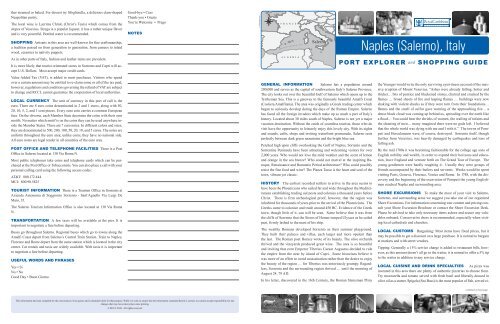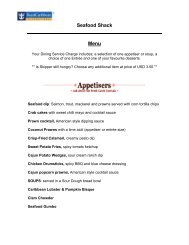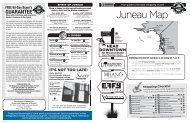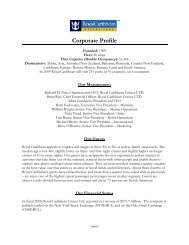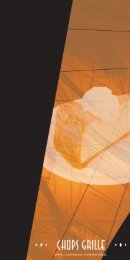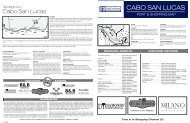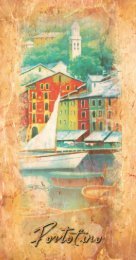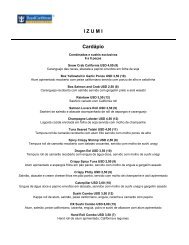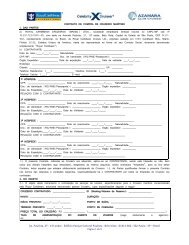Naples (Salerno), Italy - Royal Caribbean International
Naples (Salerno), Italy - Royal Caribbean International
Naples (Salerno), Italy - Royal Caribbean International
Create successful ePaper yourself
Turn your PDF publications into a flip-book with our unique Google optimized e-Paper software.
ther steamed or baked. For dessert try Sfogliatella, a delicious clam-shaped<br />
Neapolitan pastry.<br />
The local wine is Lacrima Christi (Christ’s Tears) which comes from the<br />
slopes of Vesuvius. Strega is a popular liqueur, it has a rather unique flavor<br />
and is very powerful. Bottled water is recommended.<br />
SHOPPING Artisans in this area are well-known for fine craftsmanship,<br />
a tradition passed on from generation to generation, from cameos to inlaid<br />
wood, ceramics to nativity puppets.<br />
Good-bye • Ciao<br />
Thank-you • Grazie<br />
You’re Welcome • Prego<br />
NOTES<br />
© 2010 maps.com<br />
F R A N C E<br />
M e d<br />
i t e r r<br />
a n e a n S<br />
e a<br />
<strong>Salerno</strong><br />
<strong>Naples</strong> (<strong>Salerno</strong>), <strong>Italy</strong><br />
As in other parts of <strong>Italy</strong>, fashion and leather items are prevalent.<br />
It is more likely that tourist orientated stores in Sorrento and Capri will accept<br />
U.S. Dollars. Most accept major credit cards.<br />
A L G E R I A<br />
PORT EXPLORER and SHOPPING GUIDE<br />
Value Added Tax (VAT), is added to most purchases. Visitors who spend<br />
over a certain amount may be entitled to re-claim some or all of the tax paid,<br />
however, regulations and conditions governing the refund of VAT are subject<br />
to change and RCCL cannot guarantee the cooperation of local authorities.<br />
LOCAL CURRENCY The unit of currency in this port of call is the<br />
euro. There are 8 euro coins denominated in 2 and 1 euros, along with 50,<br />
20, 10, 5, 2, and 1 cent pieces. Every euro coin carries a common European<br />
face. On the obverse, each Member State decorates the coins with their own<br />
motifs. No matter which motif is on the coins they can be used anywhere inside<br />
the Member States. There are 7 euro notes. In different colors and sizes,<br />
they are denominated in 500, 200, 100, 50, 20, 10, and 5 euros. The notes are<br />
uniform throughout the euro area; unlike coins, they have no national side.<br />
All euro notes are legal tender in all countries of the euro area.<br />
POST OFFICE AND TELEPHONE FACILITIES There is a Post<br />
Office in <strong>Salerno</strong> located at 130 Via Roma N.<br />
Most public telephones take coins and telephone cards which can be purchased<br />
at the Post Office or Tobacconists. You can also place a call with your<br />
personal calling card using the following access codes:<br />
AT&T: 800.172.444<br />
MCI: 800.90.5825<br />
TOURIST INFORMATION There is a Tourism Office in Sorrento at<br />
Azienda Autonoma di Soggiorno Sorrento - Sant’Agnello Via Luigi De<br />
Maio, 35.<br />
The <strong>Salerno</strong> Tourism Information Office is also located at 130 Via Roma<br />
N.<br />
TRANSPORTATION A few taxis will be available at the pier. It is<br />
important to negotiate a fare before departing.<br />
Buses go throughout <strong>Salerno</strong>. Regional buses which go to towns along the<br />
Amalfi Coast depart from <strong>Salerno</strong>’s Central Train Station. Train to <strong>Naples</strong>,<br />
Florence and Rome depart from the same station which is located in the city<br />
center. Car rentals and taxis are widely available. With taxis it is important<br />
to negotiate a fare before departing.<br />
USEFUL WORDS AND PHRASES<br />
Yes • Si<br />
No • No<br />
Good Day • Buon Giorno<br />
GENERAL INFORMATION <strong>Salerno</strong> has a population around<br />
200,000 and serves as the capital of southwestern <strong>Italy</strong>’s <strong>Salerno</strong> Province.<br />
The city looks out over the beautiful Gulf of <strong>Salerno</strong> which opens up to the<br />
Tyrrhenian Sea. This is a gateway to the famously beautiful Amalfi Coast<br />
(Costiera Amalfitana). The area was originally a Greek trading center which<br />
began to seriously develop during the days of the Roman Empire. <strong>Salerno</strong><br />
has faced all the foreign invaders which make up so much a part of <strong>Italy</strong>’s<br />
history. Located about 30 miles south of <strong>Naples</strong>, <strong>Salerno</strong> is not yet a major<br />
vacation destination. Without the crush of countless tourists, those who do<br />
visit have the opportunity to leisurely enjoy this lovely city. With its sights<br />
and sounds, cafés, shops and inviting waterfront promenade, <strong>Salerno</strong> rests<br />
perfectly between dark green mountains and the bright blue sea.<br />
Perched high upon cliffs overlooking the Gulf of <strong>Naples</strong>, Sorrento and the<br />
Sorrentine Peninsula have been attracting and welcoming visitors for over<br />
2,000 years. Who would not love the mild weather and the scent of lemon<br />
and orange in the sea breeze? Who could not marvel at the inspiring Baroque,<br />
Renaissance and Romantic Period architecture? Who could possibly<br />
resist the fine food and wine? The Piazza Tasso is the heart and soul of the<br />
town, vibrant yet classic.<br />
HISTORY The earliest recorded settlers to arrive in the area seems to<br />
have been the Phoenicians who sailed far and wide throughout the Mediterranean<br />
establishing trading out posts and colonies a thousand years before<br />
Christ. There is firm archeological proof, however, that the region was<br />
inhabited for thousands of years prior to the arrival of the Phoenicians. The<br />
Greeks came to colonize and trade around 450 BC. Evidence of the Greek<br />
town, though little of it, can still be seen. Some believe that it was from<br />
the cliffs of Sorrento that the Sirens of Homer temped Ulysses as he sailed<br />
past, firmly lashed to the mast of his ship.<br />
The wealthy Romans developed Sorrento as their summer playground.<br />
They built their palaces and villas, each larger and more opulent than<br />
the last. The Roman poet Horace wrote of its beauty. The olive orchards<br />
thrived and the vineyards produced great wine. The area is so beautiful<br />
and inviting that even Emperor Tiberius Caesar Augustus decided to rule<br />
the empire from the near by island of Capri. Some historians believe it<br />
was more of an effort to avoid assassination rather than the desire to enjoy<br />
the beauty of the region … for Tiberius was notoriously grumpy. Regardless,<br />
Sorrento and the surrounding region thrived … until the morning of<br />
August 24, 79 AD.<br />
In his letter, discovered in the 16th Century, the Roman Statesman Pliny<br />
the Younger would write the only surviving eyewitness account of the massive<br />
eruption of Mount Vesuvius. “Ashes were already falling, hotter and<br />
thicker… bits of pumice and blackened stones, charred and cracked by the<br />
flames … broad sheets of fire and leaping flames … buildings were now<br />
shaking with violent shocks as if they were torn from their foundations…<br />
flames and the smell of sulfur gave warning of the approaching fire… a<br />
dense black cloud was coming up behind us, spreading over the earth like<br />
a flood… You could hear the shrieks of women, the wailing of infants and<br />
the shouting of men… many imagined there were no gods left. I believed<br />
that the whole world was dying with me and I with it.” The towns of Pompeii<br />
and Herculaneum were, of course, destroyed. Sorrento itself, though<br />
further from Vesuvius, was heavily damaged by earthquakes and tons of<br />
falling ash.<br />
By the mid 1700s it was becoming fashionable for the college age sons of<br />
English nobility and wealth, in order to expand their horizons and education,<br />
leave England and venture forth on The Grand Tour of Europe. The<br />
young gentlemen were hardly roughing it. Usually they were groups of<br />
friends accompanied by their butlers and servants. Weeks would be spent<br />
visiting Paris, Geneva, Florence, Venice and Rome. In 1748, with the discovery<br />
and the beginning of the excavation of Pompeii the young Englishmen<br />
reached <strong>Naples</strong> and surrounding area.<br />
SHORE EXCURSIONS To make the most of your visit to <strong>Salerno</strong>,<br />
Sorrento, and surrounding areas we suggest you take one of our organized<br />
Shore Excursions. For information concerning tour content and pricing consult<br />
your Shore Excursion Brochure or contact the Shore Excursion Desk.<br />
Please be advised to take only necessary items ashore and secure any valuables<br />
onboard. Conservative dress is recommended, especially when visiting<br />
local cathedrals and churches.<br />
LOCAL CUSTOMS Bargaining: Most items have fixed prices, but it<br />
may be possible to get a discount on a large purchase. It is normal to bargain<br />
at markets and with street vendors.<br />
Tipping: Generally a 15% service charge is added to restaurant bills, however,<br />
as this amount doesn’t all go to the waiter, it is normal to offer a 5% tip<br />
to the waiter in addition to any service charge.<br />
Local Cuisine and Drink Specialties As pizza was<br />
invented in this area there are plenty of authentic pizzerias to choose from.<br />
Try mozzarella and tomato served with fresh basil and liberally doused in<br />
olive oil as a starter. Spigola (Sea Bass) is the most popular of fish, served ei-<br />
continued on back page<br />
This information has been compiled for the convenience of our guests and is intended solely for that purpose. While we work to ensure that the information contained herein is correct, we cannot accept responsibility for any<br />
changes that may have taken place since printing.<br />
© RCCL 2010. All rights reserved.
SORRENTO PLACES OF INTEREST<br />
1<br />
Chiesa e Chiostro di St. Francisco (Church and Cloister<br />
of St. Francis), with its beautiful crossing arches, was built<br />
as a monastery in the early 1400s. As with many of the Catholic<br />
buildings in <strong>Italy</strong>, much of the stone work was taken from earlier<br />
pagan temples.<br />
2<br />
Palazzo Correale (Correale Palace) was built in the late<br />
1300s as the home of the old and prominent Correale family.<br />
It is designed in a combination of Gothic and Neapolitan<br />
styles. Volcanic stone was used in the arched framing of many<br />
of the windows. Two brothers, Pompeo and Alfredo, were the<br />
last decedents of the family. According to their wills and wishes,<br />
their collections of art and treasured collectables have become<br />
museum exhibits.<br />
3<br />
Casa Quattrocentesca (Fifteenth Century House), built<br />
in the late 1400s, is a beautiful building whose design and<br />
construction was influenced by the style more commonly found<br />
in the region of Tuscany.<br />
4<br />
Sorrento Cathedral is located along the beautiful Corso<br />
Italia. First begun in the late 1400’s Renaissance style, the<br />
cathedral has undergone many restorations over the years. In<br />
the sanctuary are a number of striking paintings from the 1700s<br />
as well as a marble throne for the Archbishop and wonderfully<br />
crafted wood designs created by artisans from Sorrento.<br />
5<br />
Campanile Del Duomo (The Cathedral Bell Tower)<br />
was begun in the 500s AD. The base of the tower was<br />
designed in the Roman style. The rest of the tower is designed<br />
and constructed in the Byzantine style. The area around the bell<br />
tower is where citizens would originally meet to discuss town<br />
business.<br />
6<br />
Chiesa dei Servi di Maria (Church of the Servants of<br />
Mary) was designed in the Baroque style and built in the<br />
1700s. On Good Fridays congregants of the church dress in<br />
black hooded robes and carry a wooden statue of Christ through<br />
the town.<br />
7<br />
Le Antiche Mura (The Old Wall) is a small segment of<br />
all that is left of the first defensive fortification from the<br />
original Greek town. After centuries, the wall was in the process<br />
of being rebuilt when the Turks invaded in 1561.<br />
8<br />
Sedil Dominova (Seat of the Rulers), built in the 1400s,<br />
as were many of the buildings in Sorrento, was the official<br />
meeting place of the town’s nobles. It was from here that the<br />
leaders worked out the town’s daily business. The dome of the<br />
hall is covered in beautiful frescos from the 1700s. The crests<br />
of Sorrento’s leading families still adorn the walls.<br />
9<br />
Chiesa del Rosario (Church of the Rosary) is believed<br />
to have been built in the early 300s AD during the reign<br />
of Emperor Constantine. As with many of the earliest Catholic<br />
churches, Saint Rosary, as it is usually referred to, was constructed<br />
upon the site using many of the materials of a Roman<br />
pagan temple. From 11-1400 AD, known as the church of Saint<br />
Felice and Baccolo, it was the main cathedral of Sorrento.<br />
10<br />
The Museo Bottega, built in the 1700s, is home to a<br />
nice collection of art, furniture and especially the works<br />
of intarsia, (decorative inlaid wood design). The artisans of Sorrento<br />
have long been famous for the quality of their work. It is<br />
the goal of the museum to help pass down the ancient skills and<br />
techniques to the next generation of artists and craftsmen.<br />
11<br />
2<br />
3<br />
4<br />
5<br />
6<br />
7<br />
Casa di Cornelia Tasso (House of Cornelia Tasso)<br />
was built in the early 1500s. Cornelia was the sister<br />
of Torquato Tasso. The Tasso family was very distinguished.<br />
The family had all the political and religious connections and<br />
enemies that come with such prominence. Cornelia’s brother,<br />
Torquato, was the famously gifted yet emotionally disturbed<br />
Italian poet.<br />
12<br />
Piazza Tasso is the heart of Sorrento. From this point<br />
you can get the feel of the town that has been slowly<br />
and graciously growing as it has welcomed visitors 9 from around<br />
the world over millennia.<br />
Beyond Sorrento and <strong>Salerno</strong><br />
8<br />
10<br />
11<br />
Pompeii is 14 miles east of <strong>Naples</strong> and the eruption of Vesuvius<br />
in 79 A.D. buried this town. Numerous excavations 12 have taken<br />
place and it is now the best preserved specimen of an ancient<br />
13<br />
Roman town in existence. Visitors can see the remains of public<br />
buildings, streets, temples, shops, theaters and public baths.<br />
Herculaneum was once the summer resort of wealthy Romans.<br />
It was also affected by the eruption of Vesuvius in 79 A.D. and<br />
is remarkably well preserved. Smaller than Pompeii, it offers a<br />
unique vision of private life in the Roman Empire, and was the<br />
inspiration for Paul J. Getty’s museum in Malibu, California.<br />
Mount Vesuvius is the only active volcano on the mainland<br />
of Europe. There have been many notable eruptions, the most<br />
well-known being that of 79 A.D. which did so much damage<br />
to Pompeii and Herculaneum. The last eruption took place in<br />
1944, however, there are still emissions of smoke and interior<br />
evidence of heat.<br />
Isle of Capri – This mountainous and romantic island, beautifully<br />
situated in the Bay of <strong>Naples</strong>, may be reached by jetfoil<br />
and hydrofoil.<br />
Ischia, 18 miles south-west of <strong>Naples</strong>, is the largest island in<br />
the Bay of <strong>Naples</strong> and of volcanic origin. Over the years it<br />
has become increasingly popular with tourists and may also be<br />
reached by jetfoil and hydrofoil.<br />
Amalfi Drive, east of Sorrento, is one of the most spectacular<br />
Drives in Europe, stretching along the mountains of the <strong>Salerno</strong><br />
Coast. Amalfi town was originally an important Maritime Republic<br />
and its Cathedral, built in 937 A.D., features a unique<br />
F<br />
grand stairway leading to the beautiful byzantine facade.<br />
PREFERRED SHOPPING<br />
In Sorrento<br />
A<br />
A&B - Pizzeria Aurora - Restaurant O’ Canonico -<br />
Located at Piazza Tasso 7. Family business since 1898.<br />
50 different types of genuine Neapolitan pizza made in the traditional<br />
brick oven. Homemade pastas with seafood, meat or<br />
JK<br />
tomato sauce. More than 1500 types of the best Italian wines.<br />
LM<br />
80 Different Types of Homemade Liquors: Limoncello (lemon<br />
liquor), wild fennel, basil, orange. Wine Shop: Take away package<br />
located inside the restaurant; shipping available. N Advertised<br />
on Wine Spectator for the “best selecion of wine”. English<br />
speaking, fast and friendly service. O<br />
B<br />
Gioielleria Di Somma - Love and Passion for the Tradition<br />
of Goldsmith Artistry. Located at Corso<br />
P<br />
Italia, 114.<br />
Jewelry Brands: Chantecler, Pomellato, Pianegonda, Dodo,<br />
Montblanc, Leo Pizzo, Hermes, Crivelli. Watch Brands: Mont-<br />
E<br />
G<br />
H<br />
I<br />
12 13<br />
11<br />
10<br />
blanc, Hermes, TCM, Pirelli, Graham, Arnod & Son. Every<br />
piece of jewelry is handcrafted and comes with a guarantee<br />
of the high quality of the diamonds and colored gems. Their<br />
weight is shown in carats and the gold is guaranteed 750/000<br />
(18K). Exclusive baby jewelry collection.<br />
C<br />
Notturno - Inlaid Wood Works Factory and Showroom.<br />
Located at Via Fuorimura 33; Ask your Port & Shopping<br />
Guide for Transportation to Visit the Factory. Free demonstration<br />
of beautiful craftsmanship. Wooden Objects: Jewelry<br />
boxes, cigar boxes, pictures, trays, coasters, grandfa¬ther<br />
clocks, clocks, game tables, dining rooms, bedrooms, tables,<br />
photo albums, chess boards, chess sets, wooden toys and many<br />
wooden souvenirs. Murano jewelry and Christmas ornaments.<br />
Worldwide shipping available; Tax-free purchases.<br />
D<br />
SORRENTO<br />
Harmony Gift Center - Located at Via Fuoro, 25 Sorrento.<br />
Inlaid wood works. Wide selection of gift items to<br />
take home as souvenirs. Don’t miss the famous Madame Alexander<br />
Collection Dolls and My Doll, the doll of the heart.<br />
9<br />
6<br />
D<br />
In Capri<br />
7<br />
1<br />
4 5<br />
15<br />
8<br />
B<br />
3<br />
16<br />
17<br />
2<br />
19<br />
14<br />
18<br />
Chantecler - This Exquisite Jewelry Store is a Must See for<br />
all Chic Visitors to Capri! Located at 51 Via Vittorio Emanuele.<br />
First jewelry store to open in Capri; Specializing in high<br />
quality and fine workmanship; Each piece is like a work of art.<br />
Jewelry: Jewelry that is so elegant, you’ll never want to take<br />
it off; Diamonds, rubies, sapphires and emeralds are carefully<br />
selected for their purity and color. Famous Clientele: Jacqueline<br />
Onassis, Grace Kelly, Audrey Hepburn, Greta Garbo, Joan<br />
Crawford, Lex Barker and Henry Fonda. Expert gemologist<br />
onsite.<br />
Carthusia - Located at: Viale Parco Augusto, 2 in Capri; Via<br />
Federico Serena, 28 in Capri; Via Camerelle, 10 in Capri; Viale<br />
Axel Munthe, 26 in Anacapri; Corso Italia, 117 – Sorrento,<br />
Since 1948; The smallest laboratory of perfumes in the world.<br />
Limited production using the same methods as the Carthsian<br />
monks. Located near the Augustus Garden in Capri with also<br />
factory store showrooms in Anacapri and Sorrento.<br />
Optical Capri/Capri People - Located at Via Le Botteghe 27<br />
AB<br />
AA<br />
C<br />
in Capri. The most exclusive optical shop in Capri. Handmade<br />
sun and prescription glasses of Capri People collections with<br />
polarized and 100% UV protection lenses. Wide Selection of<br />
Fashion and Luxury Eyewear: Gold & wood Paris, Chanel,<br />
Theo, Prada, Gucci, YSL, Maui Jim, Porche, Armani, Starck,<br />
Tom Ford, Alain Mikli, Bugatti.<br />
Please contact us at EuropeShopping@rccl.com if any<br />
queries arise after your purchase from our preferred shops<br />
on shore. We will do our best to facilitate a solution on<br />
your behalf.<br />
© 2010 maps.com


